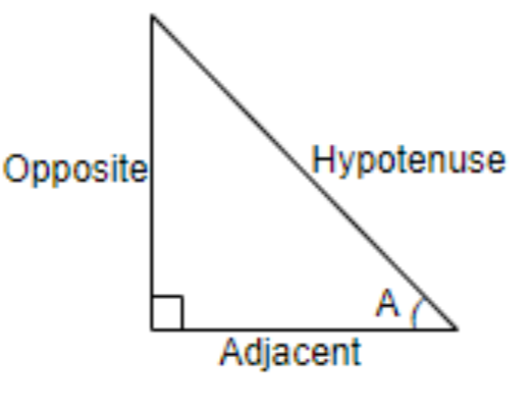
If we have the trigonometric ratio as $8\tan A=15$, then find the value of the expression $\sin A-\cos A$.
Answer
575.7k+ views
Hint: Here, first draw the right-angled triangle and use the trigonometric ratios to find sin A and cos A from tan A. We will get all the values of the opposite side, adjacent side, and the hypotenuse. In the end, after finding sin A and cos A, subtract them according to the question and obtain the required result.
Complete step-by-step solution:
We have been given the question that, $8\tan A=15$. From this, we can write, $\tan A=\dfrac{15}{8}$.
Now, let us draw a right-angled triangle and indicate the angle A.

According to the trigonometric ratios, we know,
$\tan \theta =\dfrac{\text{Opposite}}{\text{Adjacent}}$
We have, $\tan A=\dfrac{15}{8}$.
Therefore, on comparing the above equations we can see that, the opposite side = 15 and the adjacent side = 8.
We also know that,
$\sin \theta =\dfrac{\text{Opposite}}{\text{Hypotenuse}}=\dfrac{\text{O}}{\text{H}}$
So, we have the opposite side = 15, so we can write,
$\sin A=\dfrac{15}{\text{H}}$
We also know that,
$\cos \theta =\dfrac{\text{Adjacent}}{\text{Hypotenuse}}=\dfrac{\text{A}}{\text{H}}$
We have the adjacent side = 8, so we can write,
$\cos A=\dfrac{8}{\text{H}}$
We know that Pythagoras theorem is given by,
${{\left( \text{Hypotenuse} \right)}^{\text{2}}}\text{=}{{\left( \text{Opposite side} \right)}^{\text{2}}}\text{+}{{\left( \text{Adjacent side} \right)}^{\text{2}}}$
On substituting the values, we get,
$\begin{align}
& {{\left( \text{Hypotenuse} \right)}^{\text{2}}}\text{=}{{\left( 15 \right)}^{\text{2}}}\text{+}{{\left( 8 \right)}^{\text{2}}} \\
& =225+64 \\
& =289 \\
\end{align}$
On taking the square root on both the sides, we get,
\[\text{Hypotenuse =}\sqrt{289}=17\]
Now, on substituting the value of hypotenuse in $\sin A=\dfrac{15}{\text{H}}$ and $\cos A=\dfrac{8}{\text{H}}$, we get,
$\sin A=\dfrac{15}{17}$ and $\cos A=\dfrac{8}{17}$
Now, we are supposed to find $\sin A-\cos A$, so we will get,
$\begin{align}
& \sin A-\cos A=\dfrac{15}{17}-\dfrac{8}{17} \\
& =\dfrac{15-8}{17} \\
& =\dfrac{7}{17} \\
\end{align}$
Therefore, we get the value of $\sin A-\cos A=\dfrac{7}{17}$.
Note: Trigonometry is the branch of mathematics that deals with the relations of sides and angles of triangles and with the relevant functions of any angles. There are six trigonometric ratios, sine, cosine, tangent, cosecant, secant, and cotangent. The hypotenuse is known as the longest side in the right-angled triangle. We can only use the Pythagoras theorem, if there is an angle of ${{90}^{\circ }}$ in the triangle.
Out of all the six trigonometric functions, sine, cosine, and tangent are most commonly used to solve problems related to the trigonometric equations. In the first quadrant, all the trigonometric functions are positive, in the second quadrant, only sine and cosecant are positive, in the third quadrant, only tangent and cotangent are positive, and in the fourth quadrant, only cosine and secant are the positive trigonometric functions.
Complete step-by-step solution:
We have been given the question that, $8\tan A=15$. From this, we can write, $\tan A=\dfrac{15}{8}$.
Now, let us draw a right-angled triangle and indicate the angle A.

According to the trigonometric ratios, we know,
$\tan \theta =\dfrac{\text{Opposite}}{\text{Adjacent}}$
We have, $\tan A=\dfrac{15}{8}$.
Therefore, on comparing the above equations we can see that, the opposite side = 15 and the adjacent side = 8.
We also know that,
$\sin \theta =\dfrac{\text{Opposite}}{\text{Hypotenuse}}=\dfrac{\text{O}}{\text{H}}$
So, we have the opposite side = 15, so we can write,
$\sin A=\dfrac{15}{\text{H}}$
We also know that,
$\cos \theta =\dfrac{\text{Adjacent}}{\text{Hypotenuse}}=\dfrac{\text{A}}{\text{H}}$
We have the adjacent side = 8, so we can write,
$\cos A=\dfrac{8}{\text{H}}$
We know that Pythagoras theorem is given by,
${{\left( \text{Hypotenuse} \right)}^{\text{2}}}\text{=}{{\left( \text{Opposite side} \right)}^{\text{2}}}\text{+}{{\left( \text{Adjacent side} \right)}^{\text{2}}}$
On substituting the values, we get,
$\begin{align}
& {{\left( \text{Hypotenuse} \right)}^{\text{2}}}\text{=}{{\left( 15 \right)}^{\text{2}}}\text{+}{{\left( 8 \right)}^{\text{2}}} \\
& =225+64 \\
& =289 \\
\end{align}$
On taking the square root on both the sides, we get,
\[\text{Hypotenuse =}\sqrt{289}=17\]
Now, on substituting the value of hypotenuse in $\sin A=\dfrac{15}{\text{H}}$ and $\cos A=\dfrac{8}{\text{H}}$, we get,
$\sin A=\dfrac{15}{17}$ and $\cos A=\dfrac{8}{17}$
Now, we are supposed to find $\sin A-\cos A$, so we will get,
$\begin{align}
& \sin A-\cos A=\dfrac{15}{17}-\dfrac{8}{17} \\
& =\dfrac{15-8}{17} \\
& =\dfrac{7}{17} \\
\end{align}$
Therefore, we get the value of $\sin A-\cos A=\dfrac{7}{17}$.
Note: Trigonometry is the branch of mathematics that deals with the relations of sides and angles of triangles and with the relevant functions of any angles. There are six trigonometric ratios, sine, cosine, tangent, cosecant, secant, and cotangent. The hypotenuse is known as the longest side in the right-angled triangle. We can only use the Pythagoras theorem, if there is an angle of ${{90}^{\circ }}$ in the triangle.
Out of all the six trigonometric functions, sine, cosine, and tangent are most commonly used to solve problems related to the trigonometric equations. In the first quadrant, all the trigonometric functions are positive, in the second quadrant, only sine and cosecant are positive, in the third quadrant, only tangent and cotangent are positive, and in the fourth quadrant, only cosine and secant are the positive trigonometric functions.
Recently Updated Pages
Two men on either side of the cliff 90m height observe class 10 maths CBSE

What happens to glucose which enters nephron along class 10 biology CBSE

Cutting of the Chinese melon means A The business and class 10 social science CBSE

Write a dialogue with at least ten utterances between class 10 english CBSE

Show an aquatic food chain using the following organisms class 10 biology CBSE

A circle is inscribed in an equilateral triangle and class 10 maths CBSE

Trending doubts
Why is there a time difference of about 5 hours between class 10 social science CBSE

Write a letter to the principal requesting him to grant class 10 english CBSE

What is the median of the first 10 natural numbers class 10 maths CBSE

The Equation xxx + 2 is Satisfied when x is Equal to Class 10 Maths

Which of the following does not have a fundamental class 10 physics CBSE

State and prove converse of BPT Basic Proportionality class 10 maths CBSE




